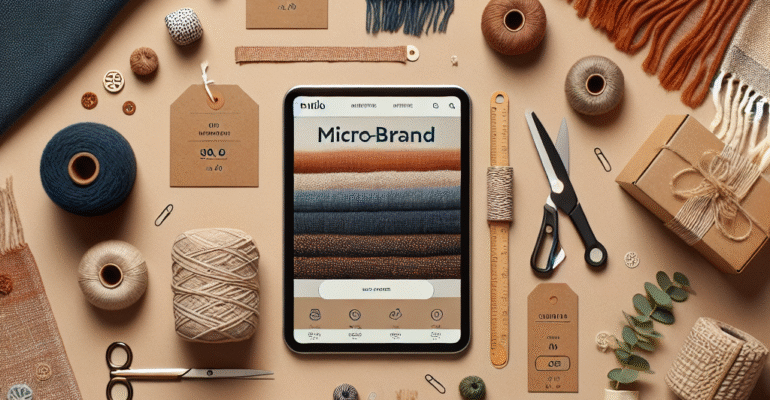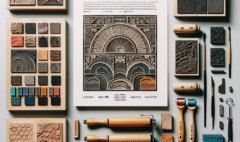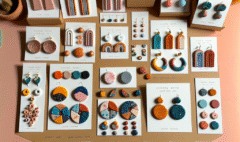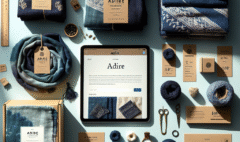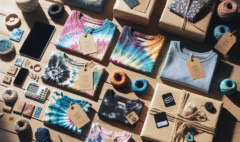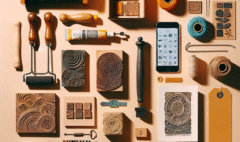Threads to Thrive: Launch a Profitable Handwoven Accessories Micro‑Brand in 21 Days
Threads to Thrive: Launch a Profitable Handwoven Accessories Micro‑Brand in 21 Days
Threads to Thrive: Launch a Profitable Handwoven Accessories Micro‑Brand in 21 Days
A continent does not forget the hand that wove its stories. Africa stitched political power into cloth, smuggled resistance into pattern, and turned thread into testimony. From Faso Dan Fani in Burkina Faso, worn by Thomas Sankara as a public refusal to bow to imported consumerism, to Kente draped on Kwame Nkrumah at independence rallies in Ghana, handwoven textiles have always existed beyond fashion. They are archive and argument. Today, as global supply chains stutter and audiences crave integrity, handweaving is not a quaint hobby. It is a comeback side hustle that can seed a micro-brand with teeth, depth, and cash flow.
====
Why Handweaving Is the Comeback Side Hustle
- Heritage craft meets modern micro-brand. Handweaving translates history into commerce without losing soul. You can launch small, own your process, and scale with integrity. It is slow enough to be meaningful, fast enough to be viable.
- Postcolonial correction. For a century, British and other European mills flooded African markets with cheap cotton prints that undercut local weaving guilds. Building a micro-brand in cloth is an act of economic self-definition, a small but tangible reversal of extractive trade patterns.
-
Cultural capital travels. A scarf woven in Lagos can find a buyer in Lisbon. A camera strap made in Addis can sell in Accra. The world understands texture. Your job is to package that texture with clarity.
-
Mobile friendly, cash-flow friendly. Low upfront capital. High perceived value. Lean inventory. This is not fast fashion. It is fast validation, then deliberate growth.
====
A Story To Ground It: The Loom In Ouagadougou
Mariam was a history teacher before she was a weaver. In 2017, inspired by archival photos of Sankara urging Burkinabè to wear local cloth, she borrowed a tabletop loom, learned a basic plain weave, and sampled a rough band of cotton in rust and leaf green. She posted a short video that showed only her hands, warp taut, weft whispering across. The clip reached a local singer who commissioned fifteen guitar straps for a summer tour. Mariam priced them honestly, paid her cousin to help hem and add leather tabs, and finished the order in two weekends. She used the profits to buy better yarn and a second loom. By 2020, her brand was stocked in three boutiques. She still teaches, yet the loom pays for her children’s school fees. The story is not romantic. It is operational. She built a system.
====
21-Day Roadmap Overview
Phase 1 Build, Days 1 to 7
- Choose your loom, assemble tools.
- Define signature colors and patterns.
- Set up workspace, safety, and workflow.
- Create your brand name, logo kit, and labels.
- Draft cost and pricing matrix.
- Open your sales stack, Etsy or Shopify.
Phase 2 Weave, Days 8 to 14
- Plan warps for 3 to 5 pieces per batch.
- Sample, test density, record settings.
- Weave your initial SKUs.
- Finish and label completed pieces.
- Photograph process and lifestyle shots.
Phase 3 Sell, Days 15 to 21
- Write product pages, optimize SEO.
- Open waitlist and preorders.
- Launch with a limited drop and early-bird bundle.
- Pitch micro-influencers and local boutiques.
- Collect feedback, tune pricing, and queue the next batch.
====
Tools and Materials on Any Budget
Looms
- Rigid heddle or tabletop loom, 24 inches is a sweet spot for scarves and runners. Budget brands include Ashford, Schacht Cricket, Kromski Harp. For ultra-lean, a backstrap loom or improvised frame loom works, especially for straps and belts.
Yarns
- Cotton for durability. Wool or alpaca for softness. Linen for crisp runners. Start with 8 to 10 wraps per centimeter for scarves, 12 to 14 for straps. Workhorse weights include 8-2 cotton and DK wool.

Shuttles and Warping Tools
- Stick shuttle, boat shuttle, warping peg, clamp. Lease sticks if you have them. If not, use smooth ruler wood. A sturdy comb can serve as a reed on a frame loom in a pinch.
Thrifted and Local Alternatives
- Upcycle cotton cones from local factories. Thrift old linen for weft in mug rugs. Ask tailors for offcuts to test color pairings. Use binder clips as tension helpers.
Basic Consumables
- Masking tape, measuring tape, scissors, tapestry needle, spray bottle, mild soap, label tape.
====
Weaving Basics in 60 Minutes
- Warp planning. Decide finished width, add shrinkage allowance, then calculate ends per centimeter based on yarn. Multiply by width to get total ends. Add two extra ends for selvedge security.
-
Threading and tension. Slot-and-hole threading on a rigid heddle is forgiving. Keep tension even. The warp should ping like a low guitar string, not sag, not scream.
-
Plain weave versus twill. Plain weave is simple and strong, perfect for mug rugs and scarves. Twill, including herringbone, adds diagonal movement and interest. Shift your pattern every few picks to maintain rhythm.
-
Sampling for density. Weave a 10 centimeter sample with your intended beat. Wet finish. Measure the draw-in and shrinkage. Adjust sett and beating strength. Record everything.
====
Iconic Design System
Signature Color Stories
- Indigo Clay. Deep indigo with terracotta and cream. Evokes Sahel evenings and courtyard brick.
-
Sunrise Market. Warm gold, paprika red, and leafy green. References produce stalls, rusted scales, bright wrappers.
-
Forest Trail. Moss, charcoal, and river blue. Feels like mountain fog and rain-wet bark.
Repeatable Patterns
- Plain weave. Clean, timeless, production friendly.
-
Herringbone twill. Zigzag lineage that nods to Ashanti and Berber rhythms without imitation. Use it for straps and runners where structure matters.
Keep these choices disciplined for the first three months. Customers remember coherence more than complexity.
====
Fast, Profitable SKUs
- Scarves. 3 to 4 hours weave time. Price band 45 to 120 USD depending on fiber.
-
Mug rugs, coaster sets. 45 minutes for a set of four when batched. Price band 12 to 25 USD.
-
Camera and guitar straps. 2 to 3 hours including finishing. Price band 35 to 85 USD, add leather ends.
-
Belts. 1.5 to 2 hours. Price band 25 to 60 USD.
-
Bookmarks. 30 minutes for a pair when batched. Price band 8 to 18 USD.
-
Table runners. 3 to 5 hours. Price band 60 to 150 USD.
Make one hero SKU per color story. Do not dilute your drop.
====
Dye or Buy
Quick-start natural dye notes
- Indigo. Pre-reduced indigo is safer for beginners. Wear gloves. Use a non-reactive container. Keep the vat warm. Dip slowly to avoid oxygen shock. Rinse until clear.
-
Madder. Root dye that yields brick red to peach. Simmer at sub-boil. Pre-mordant cotton with alum and washing soda for better uptake.
-
Safety. Ventilate. Label everything. No food pots. Store dyes away from children. Neutralize vats before disposal following local guidelines.
Pre-dyed sourcing list
- Look for mill ends from regional spinners. Check weaving guilds and textile schools. Online, buy from reputable suppliers known for consistent cones and dye lots.
====
Costing and Pricing Math
COGS worksheet
- Materials. Yarn per piece quantified by meters, plus labels, leather tabs, packaging.
-
Labor. Your hourly rate multiplied by weave and finishing time. Pay yourself fairly. Start at a rate that respects craft, for example 12 to 25 USD per hour depending on locale.
-
Overhead. Loom depreciation, electricity, platform fees, studio rent share.
Retail. Multiply COGS by 3 to 4 to cover profit and marketing. Wholesale. About 50 percent of retail. Margin target. Aim for 60 to 70 percent gross margin at retail. Revisit quarterly.
Simple example
- Mug rug set. Materials 3 USD. Labor 0.75 hours at 15 USD equals 11.25 USD. Overhead 1 USD. COGS 15.25 USD. Retail at 3x equals 45.75 USD. If your market ceiling is 28 USD, reduce material cost by using mill ends and batch to drop labor to 0.5 hours, then re-price at 29 USD with margin intact.
====
Production Workflow
- Batch warping. Warp for 3 to 5 pieces on one setup. Change weft to vary color stories.
-
Timeboxing. Set 90 minute sprints. Finish one step per sprint. Warp, weave, hem, press, label.
-
Kanban board. Columns include To Warp, On Loom, Finishing, Photo, Listed, Shipped. Use sticky notes or a digital board.
-
Quality control checklist. Check selvage straightness. Inspect for skipped threads, fix with a needle if minor. Test for pilling by rubbing a small area ten times. Confirm labels secure and knots trimmed.
====
Finishing and Care
- Wet finishing. Soak in lukewarm water with a mild soap. Do not wring. Press water out with towels. Lay flat or hang with support.
-
Steam press. Use a press cloth. Shape and measure to ensure consistent sizing across pieces.
-
Trimming ends. Use sharp snips. Leave a 1 centimeter tail if the design calls for visible fringe.
-
Sewn labels. Place in a consistent corner or on the reverse at the

hem. Hand stitch or machine, secure with a box stitch.
- Care card template. Front. Your brand name, piece name, size, color story. Back. Hand wash cool, mild soap, dry flat. Avoid bleach. Warm iron with press cloth. Small variations are part of the handmade character.
====
Brand in a Day
- Name. Choose something that sounds strong and travels across languages.
-
Origin story. One paragraph that ties your craft to place, memory, or movement. Keep it honest.
-
Logo kit. Primary logo, black and white variant, one mark for labels. Use a clean font. Save as PNG and SVG.
-
Labels. Woven for premium items, printed for small goods. Include fiber content and care icons.
-
Eco packaging. Kraft mailers, recycled tissue, paper tape, a handwritten note.
-
Unboxing script. Greet with name, invite them to feel the texture, tie the piece to its color story, thank them for supporting local craft, and add a QR code to care instructions.
====
Photography That Sells
Shot list
- Lifestyle in natural light on a human body or home surface.
-
Macro texture that shows weave structure.
-
Process shots, warp, shuttle, loom. Film short ASMR clips.
-
Scale shots, tape measure visible or placed on a common object.
Framing tips
- Shoot near a window. Avoid hard noon sun. Neutral backgrounds. Use the rule of thirds. Keep the brand color story consistent.
====
Product Pages That Convert
- SEO titles. Start with the item, weave, and color story. Example, Handwoven Herringbone Camera Strap, Indigo Clay.
-
Benefit-led copy. Talk about comfort, durability, story, and how it will be used. Link to care and repair.
-
Sizing. Give measurements before and after wash.
-
Story. One line on the inspiration. Do not lecture. Invite.
-
FAQs. Shipping times, custom options, care, returns.
-
Policies. Clear and short. No surprises.
====
Sales Stack Setup
- Etsy or Shopify in two hours. Choose one. Connect payments. Set shipping profiles with weights and regions.
-
Keyword research. Search Etsy autocomplete. Note phrases customers use, like handwoven scarf cotton, camera strap African textile.
-
Listing template. Copy and paste a base listing field set, change title, images, and SKU.
-
Launch coupon. 10 percent off for the first 20 orders. Time bound.
====
21-Day Content Calendar
- Daily posts. Alternate between ASMR weaving clips, before and after finishing moments, founder portrait and voice, drop countdowns, and behind-the-scenes of packaging.
-
Weekly anchors. Monday process, Wednesday story, Friday product reveal. Sunday rest or recap.
-
Calls to action. Invite viewers to join the waitlist, vote on colors, or share how they style similar pieces.
====
Launch Playbook
- Waitlist. Collect emails on day 5 with a simple form. Offer early access.
-
Preorders. Open limited preorders on day 15 for two SKUs. Cap to protect timelines.
-
Drops. Position the first batch as a numbered edition. Scarcity must be honest.
-
Early-bird bundles. Mug rug plus bookmark set, 10 percent off.
-
Micro-influencer seeding. Ship three straps to photographers who already like handcraft, not to generic lifestyle pages.
-
Email welcome series. Three emails. Your story and values. How the pieces are made and cared for. Launch invite with code.
====
Offline Revenue
- Craft markets. Bring a tidy rack, a price list, and your care cards. Demo a mini loom for engagement.
-
Boutiques. Prepare a line sheet with SKU names, wholesale prices, minimum order quantity, lead time, and color options.
-
Terms. Wholesale is paid 50 percent on order, 50 percent on delivery. Consignment splits average 60 to you, 40 to shop. Set a consignment term length and an inventory check date.
====
Upsells and LTV
- Care kits. Mini soap, wash bag, care card.
-
Matching sets. Scarf plus belt in the same color story.
-
Monogram tags. Stitch-on initials as a paid add-on.
-
Gift boxing. Seasonal wraps for holidays, priced to cover material and time.
-
Seasonal color drops. Rotate Indigo Clay with Indigo Storm for winter, keep names memorable.
====
Teach and Scale
- Beginner workshops. Two hours, plain weave coaster, eight students max.
-
DIY loom kits. Simple frame looms with yarn, booklet, and video link.
-
Downloadable patterns. PDF with sett, yarn, and color plan.
-
Private lessons. Premium rate with a project outcome.
-
Designer collaborations. Limited straps for a camera brand or belts for a denim label.
====
Finance Snapshot
Breakeven math
- Fixed monthly costs. 120 USD, platform, internet, depreciation.
-
Average gross margin per piece. 30 USD, for example.
-
Breakeven units. 120 divided by 30 equals 4 pieces per month.
Minimum viable drop
- Aim for 12 pieces in the first drop. Target revenue at 600 to 1000 USD. Enough to test, learn, and reinvest.
Cash discipline
- Pay yourself a small salary from the start. Reinvest a fixed percentage into materials and labels.
====
Sustainability and Story
- Traceable fibers. Source cotton from known mills or co-ops. Share your sources without leaking your competitive edge.
-
Fair pricing narrative. Tell buyers why you charge what you charge. Educate without scolding.
-
Waste-mi

nimizing warps. Design warps that use full cone quantities. Save offcuts for bookmarks and tags.
- Repair and refresh. Offer mending for frayed fringes, tightening for stretched straps, and re-blocking for scarves. This builds trust and extends product life.
====
Troubleshooting
- Uneven edges. Add a floating selvedge end. Slow the beat. Place a temple if available or pinch slightly after each pick.
-
Tension issues. Re-tension every 20 minutes in the first hour. If a section is loose, add a weight with a clip on the offending end.
-
Skipped threads. Use a needle to pull the weft under the missed warp. Press and set.
-
Color bleed. Prewash dyed yarns. Use color catchers on the first wet finish. If bleeding persists, treat with a vinegar bath for protein fibers or a synthrapol wash for cellulose.
====
90-Day Scale Plan
- Upgrade loom. If you sell through two consecutive drops, move to a 32 inch rigid heddle or add a second loom to keep one in warping while the other weaves.
-
Batch helpers. Hire a part-time finisher for trimming and labels. Document your finishing SOP.
-
New SKUs. Add narrow goods like key fobs first. Then move to small household items, placemats or cushion panels.
-
Quarterly cadence. Plan four collections per year tied to color stories. Retire one color story, introduce one, keep one constant.
====
What Makes This Playbook Different
We have explored many ways to build small creative businesses. Most guides orbit digital products or imported goods. This playbook is different because it grounds strategy in tactile making, rooted in African textile lineage. It treats a micro-brand as both an economic engine and a cultural statement. It borrows the urgency of political history and applies it to operations, so your drop calendar has the same discipline as your loom.
====
Cultural Context, Without Costume
History matters, but it does not license imitation. If you draw from Kente or Aso Oke or Kanga, cite your influences, avoid sacred patterns, and give credit or collaborate. The goal is not to cosplay identity. The goal is to build livelihoods with respect, modernity, and pride.
====
A Short Field Guide To Inspiration That Sells Ethically
- Leaders who wore their politics. Sankara in Faso Dan Fani. Nkrumah in Kente. Julius Nyerere with kanga that carried phrases of community. These are not costumes. They are manifestos in cloth.
-
Regions with living practice. Indigo pits of Kano. Mud-dyed bogolan workshops in Mali. Narrow strip weaving in Ghana and Togo. Ethiopian shemma shawls in the highlands.
-
Translate, do not copy. Turn a proverb about rain into a Forest Trail palette. Let a market scene guide your Sunrise Market set. Make your own story, then share the root.
====
Checklist For Day 21
- Ten listings live with SEO titles and clean photography.
-
Email list warmed with three messages.
-
Launch coupon tested and active.
-
Three boutique pitches sent with line sheet attached.
-
Next warp designed and ready.
====
Call To Action
If a continent stitched resistance into cloth, what story will you weave and sell in the next 21 days, and who will you pay back with the first profits you make?
====
Sources and Further Reading
- Harsch, Ernest. Thomas Sankara, An African Revolutionary. Ohio University Press, 2014.
-
Smithsonian National Museum of African Art. Kente Cloth, symbols and history. Museum collection notes and education resources.
-
Victoria and Albert Museum. Indigo dyeing techniques and safety guidelines. V and A Learning.
-
Rodney, Walter. How Europe Underdeveloped Africa. Bogle-L’Ouverture Publications, 1972. For context on colonial trade patterns.
-
British Library. East African kanga textiles, history and social messages. Asian and African studies blog.
-
Interweave. Rigid heddle weaving basics, warp, sett, and finishing. Interweave.com tutorials.
-
Shopify Help Center. Getting started with products, shipping, and payments. help.shopify.com.
-
FAO and WHO. Natural dyes and small-scale craft safety practices. UN technical notes.
Continue

